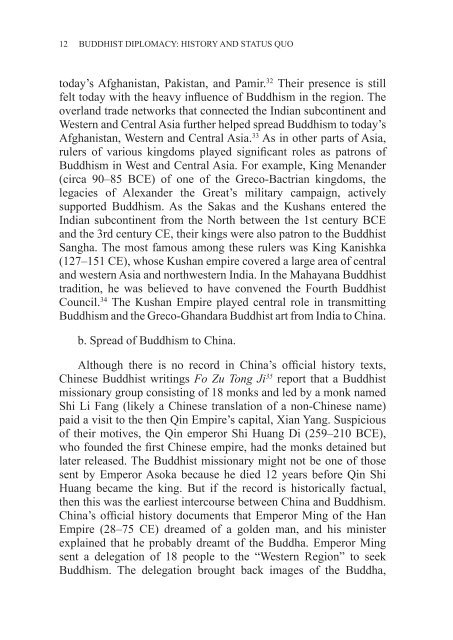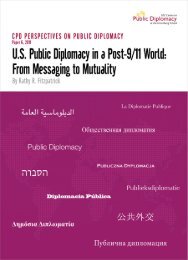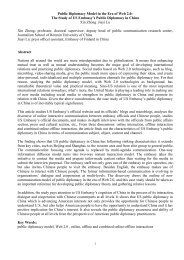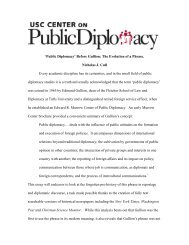Buddhist Diplomacy: History And Status Quo. - USC Center on ...
Buddhist Diplomacy: History And Status Quo. - USC Center on ...
Buddhist Diplomacy: History And Status Quo. - USC Center on ...
- No tags were found...
You also want an ePaper? Increase the reach of your titles
YUMPU automatically turns print PDFs into web optimized ePapers that Google loves.
12 BUDDHIST DIPLOMACY: HISTORY AND STATUS QUOtoday’s Afghanistan, Pakistan, and Pamir. 32 Their presence is stillfelt today with the heavy influence of Buddhism in the regi<strong>on</strong>. Theoverland trade networks that c<strong>on</strong>nected the Indian subc<strong>on</strong>tinent andWestern and Central Asia further helped spread Buddhism to today’sAfghanistan, Western and Central Asia. 33 As in other parts of Asia,rulers of various kingdoms played significant roles as patr<strong>on</strong>s ofBuddhism in West and Central Asia. For example, King Menander(circa 90–85 BCE) of <strong>on</strong>e of the Greco-Bactrian kingdoms, thelegacies of Alexander the Great’s military campaign, activelysupported Buddhism. As the Sakas and the Kushans entered theIndian subc<strong>on</strong>tinent from the North between the 1st century BCEand the 3rd century CE, their kings were also patr<strong>on</strong> to the <str<strong>on</strong>g>Buddhist</str<strong>on</strong>g>Sangha. The most famous am<strong>on</strong>g these rulers was King Kanishka(127–151 CE), whose Kushan empire covered a large area of centraland western Asia and northwestern India. In the Mahayana <str<strong>on</strong>g>Buddhist</str<strong>on</strong>g>traditi<strong>on</strong>, he was believed to have c<strong>on</strong>vened the Fourth <str<strong>on</strong>g>Buddhist</str<strong>on</strong>g>Council. 34 The Kushan Empire played central role in transmittingBuddhism and the Greco-Ghandara <str<strong>on</strong>g>Buddhist</str<strong>on</strong>g> art from India to China.b. Spread of Buddhism to China.Although there is no record in China’s official history texts,Chinese <str<strong>on</strong>g>Buddhist</str<strong>on</strong>g> writings Fo Zu T<strong>on</strong>g Ji 35 report that a <str<strong>on</strong>g>Buddhist</str<strong>on</strong>g>missi<strong>on</strong>ary group c<strong>on</strong>sisting of 18 m<strong>on</strong>ks and led by a m<strong>on</strong>k namedShi Li Fang (likely a Chinese translati<strong>on</strong> of a n<strong>on</strong>-Chinese name)paid a visit to the then Qin Empire’s capital, Xian Yang. Suspiciousof their motives, the Qin emperor Shi Huang Di (259–210 BCE),who founded the first Chinese empire, had the m<strong>on</strong>ks detained butlater released. The <str<strong>on</strong>g>Buddhist</str<strong>on</strong>g> missi<strong>on</strong>ary might not be <strong>on</strong>e of thosesent by Emperor Asoka because he died 12 years before Qin ShiHuang became the king. But if the record is historically factual,then this was the earliest intercourse between China and Buddhism.China’s official history documents that Emperor Ming of the HanEmpire (28–75 CE) dreamed of a golden man, and his ministerexplained that he probably dreamt of the Buddha. Emperor Mingsent a delegati<strong>on</strong> of 18 people to the “Western Regi<strong>on</strong>” to seekBuddhism. The delegati<strong>on</strong> brought back images of the Buddha,











